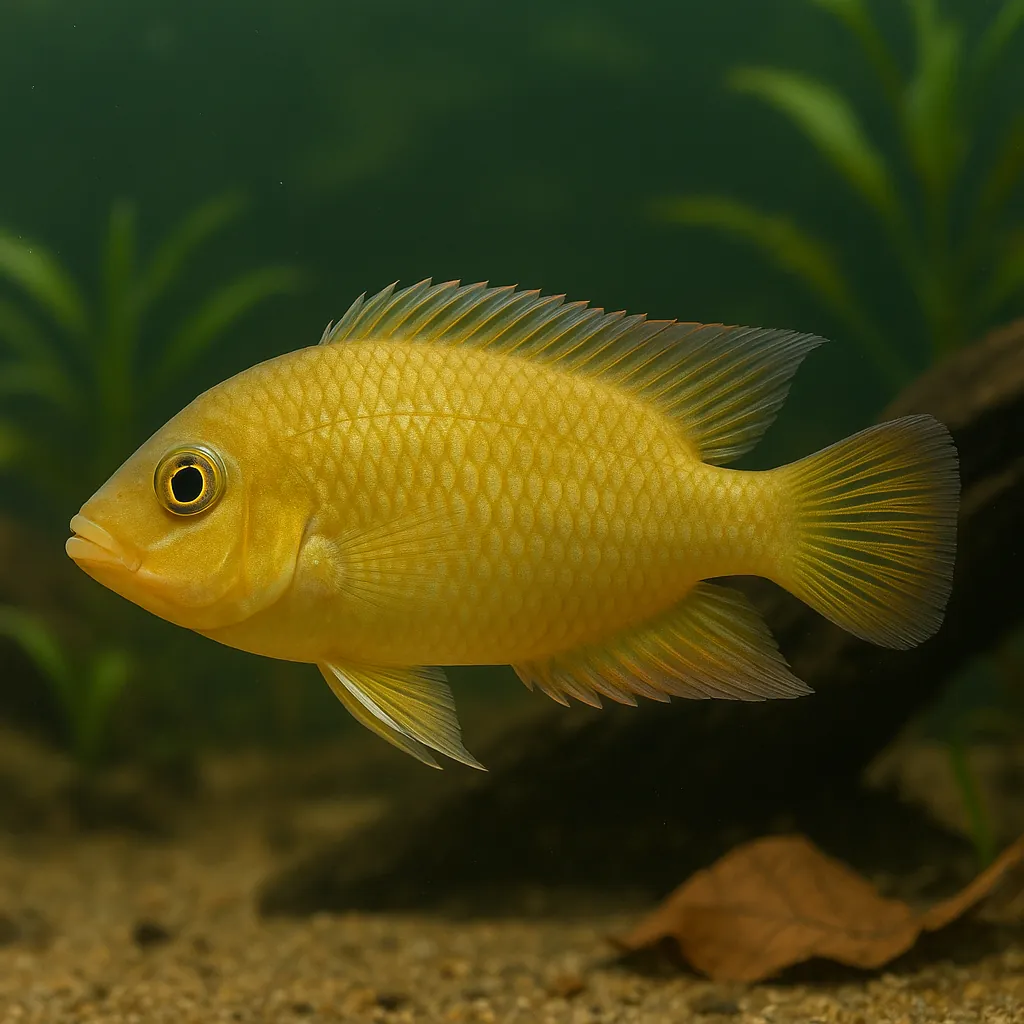
Yellow acara
Introduction
The Yellow Acara (Aequidens metae) is a captivating freshwater cichlid native to South America, particularly Colombia's Meta River in the Orinoco River basin. Renowned for its vibrant yellow-green coloration and distinctive black markings, this species appeals to aquarists seeking a moderately sized, peaceful cichlid. With proper care, the Yellow Acara can thrive in home aquariums, offering both visual appeal and engaging behavior.
What makes the Yellow Acara a popular choice among aquarists?
Its striking coloration, manageable size, and generally peaceful temperament make it suitable for community tanks with compatible species.
Is the Yellow Acara suitable for beginner fishkeepers?
Yes, with proper research and commitment to maintaining stable water conditions, beginners can successfully keep Yellow Acaras.
Care and Environment
Providing optimal care for the Yellow Acara involves attention to tank size, water parameters, diet, and habitat setup.
What is the minimum tank size for a Yellow Acara?
A minimum of 160 liters is recommended for a single pair to ensure adequate space and stable water conditions.
What are the ideal water parameters for Yellow Acaras?
Maintain a temperature between 24°C and 28°C, pH levels from 5.0 to 7.0, and water hardness between 1 to 15 dGH.
Filtration should be efficient to handle the bioload, with moderate water flow to mimic their natural habitat. Lighting can be subdued, especially if using floating plants to diffuse light.
As omnivores, Yellow Acaras accept a variety of foods, including high-quality flakes, pellets, live, and frozen foods like brine shrimp and bloodworms. Incorporating plant matter such as spinach and peas is beneficial.
Decorate the tank with sturdy plants, rocks, and driftwood to create hiding spots. Be aware that they may dig, so secure plants properly. A sandy or fine gravel substrate is ideal.
While generally peaceful, they can exhibit aggression during breeding. Providing ample space and hiding spots can help mitigate territorial disputes.
How can I reduce aggression during breeding?
Ensure the tank is spacious with plenty of hiding spots to allow fish to establish territories and reduce conflicts.
Origin and Habitat
The Yellow Acara is endemic to Colombia's Meta River, part of the Orinoco River basin. In the wild, they inhabit creeks and small streams with slow-moving, tannin-stained waters. These environments are often rich in submerged vegetation, with sandy or gravel substrates and overhanging tree cover, providing ample hiding spots and a diverse diet.
What type of environment does the Yellow Acara prefer in the wild?
They thrive in slow-moving, tannin-stained waters with abundant vegetation and sandy or gravel substrates.
How can I replicate their natural habitat in my aquarium?
Use a sandy substrate, include driftwood and plants to create hiding spots, and maintain soft, slightly acidic water conditions.
Temperament and Compatibility
Yellow Acaras are generally peaceful but can become territorial during breeding. They are best kept with similarly sized, non-aggressive fish. Suitable tank mates include other peaceful cichlids, larger tetras, and peaceful barbs. Avoid housing them with overly aggressive species or very small fish that might be seen as prey.
Can Yellow Acaras be kept with other cichlids?
Yes, they can coexist with other peaceful cichlids of similar size, provided the tank is spacious enough to prevent territorial disputes.
Are Yellow Acaras suitable for community tanks?
Yes, when housed with compatible species that share similar water parameter requirements and temperaments.
Interesting Facts
During spawning and brood care, Yellow Acaras exhibit a striking color change: their eyes become luminescent yellow-orange, and their opercula, chest, and throat darken significantly. This species was first described in 1922 by Carl H. Eigenmann, with its name referencing the Meta River where it was discovered. Breeding in captivity can be challenging, often requiring simulation of rainy season conditions to induce spawning.
Why is breeding Yellow Acaras considered challenging?
They are selective in choosing mates, and specific environmental cues, like simulating the rainy season, are often needed to trigger spawning.
What is the significance of their name?
The species name "metae" refers to the Meta River in Colombia, highlighting their native habitat.
Sources
All information in this article has been gathered from the following reputable sources:
Overview
Recommended Tank Size 63.4 Gallons (for pairs or small groups) |
Minimum Group Size 1 |
Minimum Tank Volume 42.3 Gallons |
Maximum Adult Length 6.3 inches |
Average Adult Length 5.1 inches |
Shoaling (6+ required) No |
Preferred Water Type Freshwater, soft to moderately hard, slightly acidic to neutral |
Temperature Range (°C) 24–28 |
pH Range 5.0–7.0 |
Water Hardness (dGH) 1–15 |
Typical Lifespan (years) 8 years |